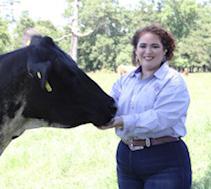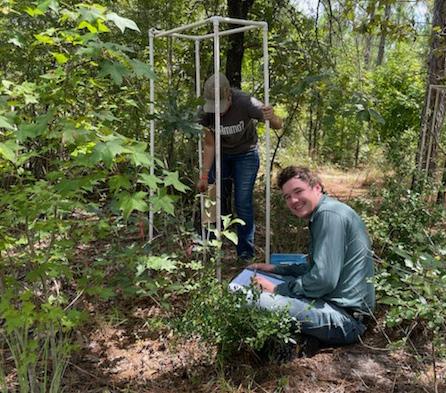
3 minute read
Graduate Research
agriCulture
Alexandria Silva
Advertisement
As more students without an agricultural background pursue degrees in the field, graduate student Alexandria Silva is assisting the SFA Agriculture Department to determine if their agriculture curriculum requires alterations to better serve students.
Silva will interview current SFA agriculture students regarding their background, as well as why they chose to pursue an agriculture degree. This qualitative data will then be analyzed for trends and additional insights.
“This subject is near and dear to my heart because I am the product of a strong agricultural background,” Silva said. “I can see that we need more people in the industry, and we need people who care. It doesn’t matter where they come from, what they wear or what they did in the past — it matters that they care for our industry the same way others do so we can cultivate an even stronger environment and create an understanding with the community and agriculturists.”
Silva, who earned a Bachelor of Science in Agriculture from SFA, now serves as an agriculture teacher at Longview High School and plans to continue building a strong National FFA Organization program within the district.
eNviroNmeNtal sCieNCe
Chikaodili Ohakawa
Environmental science graduate student Chika Ohakawa’s research will assist the Texas Department of Transportation to move forward with roadway infrastructure expansion in West Texas.
Ohakawa said the karst features present in the gypsum plains of West Texas present challenges to structural integrity for engineering activities such as road construction — especially when the expected traffic comprises heavy vehicles associated with energy sector development.
“My research involves quantifying gypsum content in soils of the Gypsum Plain within Culberson County,” Ohakawa said. “Gypsum in soils dissolves easily, leaving voids in the subsurface that increase over time and can eventually cause the collapse of structures.”
Drawing from her background in geological sciences, Ohakawa will compare three methods of gypsum analysis, including chemistry analysis, X-ray florescence and gravimetric analysis, along an existing roadway and a proposed TxDOT expansion area.
Following her analysis, Ohakawa will construct a geographic information systems map illustrating soil gypsum content along the proposed expansion route and identify areas that warrant further studies.
“I have always been fascinated with sinkholes,” Ohakawa said. “This was an interesting subject that provided me with the opportunity to work with my geology background and integrate the new things I am learning about the environmental sciences.”

22| Arthur temple College of forestry And AgriCulture
Forestry
Wyatt Bagwell
Forestry graduate student Wyatt Bagwell’s research will assess the effects of different prescribed burn regime characteristics on white-tailed deer forage and browse productivity. tailed deer in East Texas.
“I chose this research subject because prescribed burning has always interested me,” Bagwell said. “I know that doing this research will help improve the body of knowledge on whitetailed deer, thus helping land managers improve white-tailed deer habitat.”
His field work involved conducting deer browse surveys, nutrient sampling, as well as measuring forage production at five separate forests in East Texas.

In addition to assessing the impacts of different fire frequencies and seasonality on the utilization and nutritional value of preferred white-tailed deer browse species, Bagwell will examine the relationship between browse utilization and time since a prescribed burn took place. This will ultimately provide insight into the prescribed burn frequency that produces the most preferred herbaceous biomass for white-
resourCe CommuNiCatioNs
Cam Rojas
Throughout the coming year, Cam Rojas’ field work will take him to some of the Texas Parks and Wildlife Department’s most iconic state parks to conduct demographic-based visitor- use surveys in order to better understand public perceptions of state parks and quantify visitation frequencies.
“The research conducted will be utilized as a model for Texas and other states in order to promote public land advocacy, natural resource stewardship and improve relationships between the public and state agencies,” Rojas said.
Rojas, a Marine Corps veteran, said he has always felt at peace when engaging in outdoor recreation. He hopes his research will contribute to the legacy of Texas State Parks and foster positive outdoor experiences among others.
“I thoroughly enjoy the opportunity to engage with a variety of people from different backgrounds and pass on my knowledge of the outdoors to promote sustainable conservation practices, public land use and land stewardship through education, involvement and field work,” Rojas said.

fAll 2021 |23










